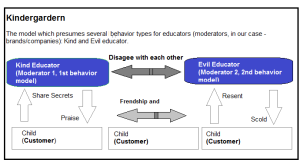Most digital agencies are faced with the task of creating “SBM-strategies”. In this article we’ll look at how you can make a creative role model for your social media marketing campaign.
Introduction
The majority of modern social marketing approaches are not applicable to the modern world. There is one main reason for this; most techniques are designed for non-promotional purposes, so they do not get results.
But what’s really amazing is that the most creative methods reveal the problems and contradictions that come from engineers, psychologists, actors and artists. Each technique is struggling with psychological inertia and is fighting stereotypes on all sides.
If you try to connect the pieces to each other in an algorithm, you get very interesting results woven intellectually from different professional spheres.
There is a system which has been developed based on adapted techniques from the different fields of psychology, game theory, programming, and linguistics. We call it a Social Behavior Algorithm.
Social Behavior Algorithm
The majority of digital marketing agencies are looking to adapt the “SBA-strategies”. To cut a long story short, we’ll focus on the following:
- How can brands communicate via social media?
- Where should brands communicate?
In most cases, it requires familiar proposals like posting “funny, attractive statuses” and pictures on one of the three social networks every day.
But we suggest using slightly modified techniques to build creative social awareness, these techniques come from psychology and sociology.
Step number 1: Transaction Byrne
It may sound familiar, but the key word in the problem is “communication.” We often forget that any SB-communication requires a response, and to this answer we need to provide another question, and so on. When such communication exists, it’s called “Transaction” (by Eric Berne), and it develops the social communication between two or more people.
Transactions consist of a combination of scenarios in which people begin to act and make decisions including buying goods, marriage, going on vacation etc. A similar scenario can be found in folklore, fairy tales, religion, and mythology. Scripts are passed from one person to another, from one community to another, from one generation to another and allow us to develop patterns of behavior.
Receipt is very simple: we are substituting real person with brand. The task is to build some type of transactional messages and to analyze previously-obtained brand communication history.
Transaction can be addressed to one of the following three:
1) I am a parent,
2) I am an adult or
3) I am a child.
According to Eric Berne’s theory, all three states exist in us from childhood. The theory is responsible for every one of the state assessments of reality and action. Simplistically, each state is responsible for the following: The parent controls the teaching and wisdom inherent in the cultural setting and moral values; the adult is responsible for rationality, training, skills, and facts while the child represents an irrational perception, emotions, hurt, and joy.
It’s very important for us to understand what exactly the “I” becomes with a particular brand in its advertising communication, because in this case we can calculate the correct response transaction.
The next level of analysis is the presence of hidden transactions. This happens when we say one thing, but assume another. For example: “Sorry, you have no money to buy this car,” says Bentley, acting as one adult to another. And actually means: “Ha-ha! There is no money in your pocket! Loser!” In this case Bentley is speaking to us as one baby to another. And this kind of behavioral transaction makes us go to the bank, apply for a loan, and buy the car.
Step 2: Role model
This is the key step where we start to design our social media strategies.
As a role model, you choose a community which could feature in the life of the consumer. The community includes a kindergarten, a circus, a fair, etc. The target audience is part of the community, which is formed by transaction roles and requires specific behavior, based on the community polices.
You start to design all behavior models, giving all the “roles of the community” users, moderators (brand), brand ambassadors, trolls, spammers – in short, to all segments of the group which you expect to attract.

You can create the model, which is familiar to the consumer to adapt to the particular model. By populating your brand transactions, you are building the community, creating a wave of your brand information and responding as you predict the strategy.
Unfortunately, about 90% of the groups in the media today appear to be a circus. Clowns on a stage are entertaining the audience with their tricks while the audience laughs.
Step 3: Mechanics Activation (categories)
The next step is to create the mechanism of activation, which is the available tool to your target audience. “Social voice” can help you to activate it. Try to go beyond the usual social media (FB, DC, VC) and imagine what other platforms you can use to work out the model. There is also WordPress, Pinterest, Linkedin Answers, Forums, Skype and Games Charts. All of these are social media platforms where a dialogue is the center of communication, which is the transaction or role-based interaction in a social hierarchy.
Determine the “Hub” i.e. the main place for publishing content. Choose the new, fast-growing service called Glabex.com.
Remember, your goal is to create a digital-tool for the user which utilizes familiar items and scenarios, through which the user can understand and accept the message from the brand.
All of these elements are the details for you mechanism for further dialogue with the user over time. You begin to understand what form you need to submit topics, contests, and games in.
Having estimated vertical tools, proceed to the formation of those tools that you need to communicate effectively.
We need to find the most appropriate associative mapping. On the one hand, we are allowed to move away from a strict analytic model and associate the root object with different levels: cultural, governmental, social, and so on to keep connected with the “parent” and thus it is logical to pursue the idea.
Read also:

Pingback: selleasy | Video Retargeted Advertising
Pingback: selleasy | The Mister of “Content”